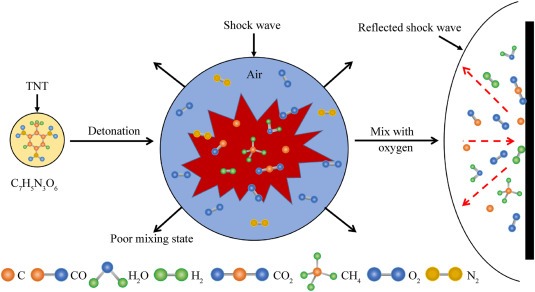Este estudio examina el efecto de la postcombustión en explosivos ricos en combustible, donde los productos de la detonación continúan ardiendo al mezclarse con el oxígeno ambiental, liberando energía adicional. La investigación introduce un modelo tridimensional que incorpora términos de reacción química para analizar los procesos de combustión en espacios confinados. Pruebas experimentales y numéricas muestran que la postcombustión libera aproximadamente el 50% de la energía en una explosión de TNT, lo que influye significativamente en la respuesta estructural al aumentar el rendimiento explosivo. Ignorar la postcombustión conlleva una reducción del 30% en la deformación estructural, mientras que su inclusión aumenta la presión cuasiestática en un 45%. A diferencia de los métodos convencionales, este enfoque elimina la dependencia de parámetros empíricos, mejorando la comprensión de la evolución de la carga explosiva en entornos como barcos, edificios y túneles.
Abstract
The detonation of fuel-rich explosives yields combustible products that persistently burn upon mixing with ambient oxygen, releasing additional energy through a phenomenon known as the afterburning effect. This process greatly influences the evolution of confined blast loading and the subsequent structural response, which is crucial in confined blast scenarios. Given the complex nature of the reaction process, accurate analysis of the afterburning effect remains challenging. Previous studies have either overlooked the mechanisms of detonation product combustion or failed to provide experimental validation. This study introduces a three-dimensional model to effectively characterize the combustion of detonation products. The model integrates chemical reaction source terms into the governing equations to consider the combustion processes. Numerical simulations and experimental tests were conducted to analyze the combustion and energy release from the detonation products of fuel-rich explosives in confined spaces. Approximately 50% of the energy was released during the combustion of detonation products in a confined TNT explosion. Although the combustion of these products was much slower than the detonation process, it aligned with the dynamic response of the structure, which enhanced the explosive yield. Excluding afterburning from the analysis reduced the center-point deformation of the structure by 30%. Following the inclusion of afterburning, the simulated quasi-static pressure increased by approximately 45%. Subsequent comparisons highlighted the merits of the proposed approach over conventional methods. This approach eliminates the reliance on empirical parameters, such as the amount and rate of energy release during afterburning, thereby laying the foundation for understanding load evolution in more complex environments, such as ships, buildings, and underground tunnels.

Fuente: https://www.sciencedirect.com


